Volume 28.2
May–August 2025
Full table of contents
ISSN: 1094-8074, web version;
1935-3952, print version
Recent Research Articles
See all articles in 28.2 May-August 2025
See all articles in 28.1 January-April 2025
See all articles in 27.3 September-December 2024
See all articles in 27.2 May-August 2024
Interested in submitting a paper to Palaeontologia Electronica?
Click here to register and submit.
Article Search
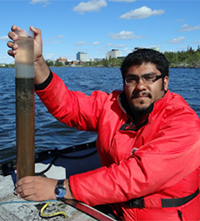 Nawaf A. Nasser. Department of Earth Sciences, Carleton University, 1125 Colonel By Drive, Ottawa, Ontario, K1S 5B6, Canada. Nawafnasser@cmail.carleton.ca
Nawaf A. Nasser. Department of Earth Sciences, Carleton University, 1125 Colonel By Drive, Ottawa, Ontario, K1S 5B6, Canada. Nawafnasser@cmail.carleton.ca
Nawaf Nasser is carrying out Ph.D. research under the supervision of Dr. Tim Patterson in the Department of Earth Science, Carleton University in Ottawa, Ontario, Canada. His research focuses on utilizing various proxies (e.g. micropaleontological, geochemical and sedimentological) to assess the impact of environmental contamination and success of remediation efforts in northern lakes. Nasser has a B.Sc. in Geology (with marine science minor) from Kuwait University, and recently completed his M.Sc. in Earth Sciences at Carleton University, where he investigated the spatial response of arcellaceans, a group of shelled benthic protists, to mining related contamination in lakes in the area of Yellowknife, Northwest Territories, Canada.

 R. Timothy Patterson. Department of Earth Sciences, Carleton University, 1125 Colonel By Drive, Ottawa, Ontario, K1S 5B6, Canada. Tim.Patterson@carleton.ca
R. Timothy Patterson. Department of Earth Sciences, Carleton University, 1125 Colonel By Drive, Ottawa, Ontario, K1S 5B6, Canada. Tim.Patterson@carleton.ca
Dr. Tim Patterson is Professor of Geology at Carleton University in Ottawa, Ontario, Canada. As a child he was infatuated with dinosaurs, assorted other extinct beasts and ancient hominids, which continued into university. After meeting professors Franco Medioli and David B. Scott of Dalhousie University he was convinced to go small. Subsequent to micropaleontologic research on freshwater thecamoebian paleoecology at Dalhousie, he was trained in foraminiferal systematics at UCLA by professors Alfred R. Loeblich Jr. and Helen Tappan. For the next 20 years he primarily specialized in paleosealevel, paleoclimate, and paleoecologic studies using foraminifera. Then one day he looked at a map and realized that Ottawa is nowhere near an ocean, unless one counts the Great Lakes. So he has returned to his thecamoebian roots. His current research interests include the use of thecamoebians as indicators of nutrient loading and metal contamination. With the help of a freeze core microtome he also carries out time series analysis at near annual resolution on thecamoebian assemblages to detect the influence of cyclic ocean-atmosphere climate drivers on limnologic hydroecology.
FIGURE 1. Map of the study region showing location of the sampled lakes (red triangles and black circles). The red triangles represent sample stations where Centropyxis pontigulasiformis was observed, while black circles characterize stations where the species was not detected. The numbers represent the sampling order, which corresponds to the sample identification codes shown in Table 1.
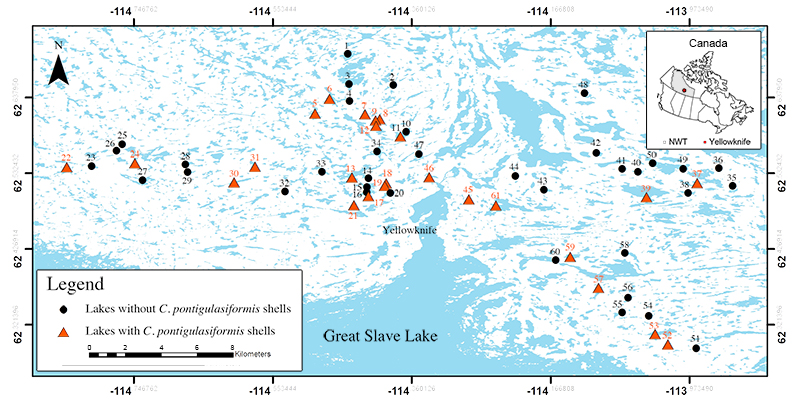
FIGURE 2. Light photomicrographs of the type illustrations of Centropyxis pontigulasiformis (as published by Beyens et al., 1986, plate 3, 1-5). 1, apertural view of the test; 2, lateral view of the test; 3, apertural view of the test; 4, apertural view of the test; and 5, a close-up on the circular aperture without the flange. The length of the scale bars represent 40 μm. Permission to reprint Beyens et al. (1986, plate 3, 1-5) was granted by Acta Protozoologica.
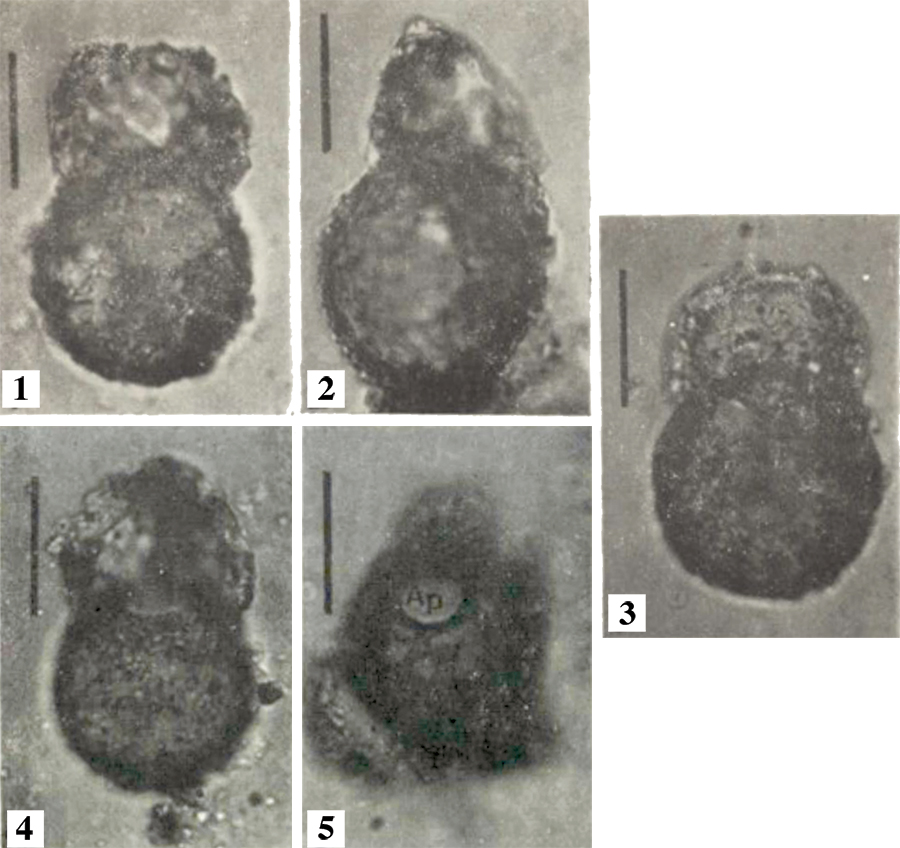
FIGURE 3. Specimens of Centropyxis aculeata (Ehrenberg, 1832), the type species of genus Centropyxis . 1, redrafted sketches of C. aculeata from Leidy (1879, plate 31) (modified after Medioli and Scott, 1983, figure 11) showing some of the typical morphotypes within the species. 2 and 3, scanning electron microscope of specimens from the lakes in the Yellowknife region, NT, Canada; ventral-apertural view showing the most common test morphology with semi-circular aperture and long spines extending from the fundus and very fine grained agglutination on ventral surface (2) and dorsal view showing xenogenous agglutination comprised both of diatom frustules and mineral grains (3).

FIGURE 4. Specimens of Conicocassis pontigulasiformis gen. et comb. nov. from lakes in Yellowknife region, Northwest Territories, Canada. 1, dorsal view of a specimen from sample BC8 showing the distinct main test body and distinctive upper funnel-like flange; 2, apertural view of a specimen collected from sample BC12 showing large aperture; 3, dorsal view of a specimen from sample BC12 with agglutination primarily comprised of large xenogenous particles; 4, oblique view of a test collected from sample BC37 showing orientation of large flange relative to apertural opening; 5, edge view of a specimen in sample BC12 showing the distinctive morphology of the main test body relative to asymmetric flange; and 6, a close-up of the flange of a specimen collected from sample BC12 clearly showing that pennate diatoms, pollen grains and mineral particles are important components of the agglutination of this specimen.
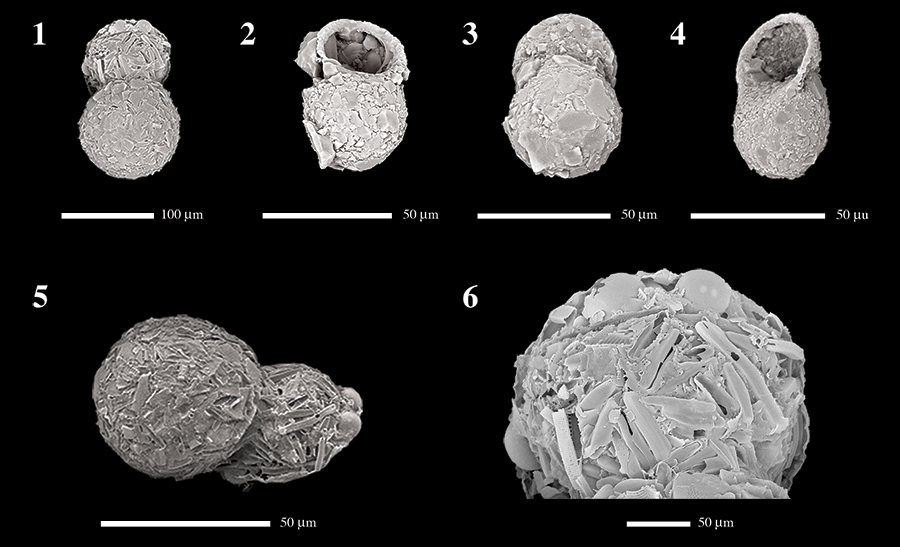
FIGURE 5. Detrended Correspondence Analysis (DCA) bi-plot based on species scores showing the faunal distribution of arcellininid species and strains in the Yellowknife region. Abbreviations: Av, Arcella vulgaris; Caa, Centropyxis aculeata “aculeata”; Cad, Centropyxis aculeata “discoides”; Cca, Centropyxis constricta “aerophila”; Ccc, Centropyxis constricta “constricta”; Ccs, Centropyxis constricta “spinosa”; Cp, Conicocassis pontigulasiformis; Ct, Cucurbitella tricuspis; Dgg, Difflugia glans “glans”; Dol, Difflugia oblonga “lanceolata”; Doo, Difflugia oblonga “oblonga”; Dos, Difflugia oblonga “spinosa”; Dot, Difflugia oblonga “tenuis”; Dpa, Difflugia protaeiformis “amphoralis”; Dpac, Difflugia protaeiformis “acuminata”; Dpcl, Difflugia protaeiformis “claviformis”; Dpcr, Difflugia protaeiformis “curvicaulis”; Dpp, Difflugia protaeiformis “protaeiformis”; Dpsc, Difflugia protaeiformis “scalpellum”; Duu, Difflugia urceolata “urceolata”; Ls, Lesquereusia spiralis; Lv, Lagenodifflugia vas; Mc, Mediolus coron; Pc, Pontigulasia compressa.

FIGURE 6. Redundancy Analysis (RDA) species-environment-sample tri-plot. Environmental variables (arrows) are shown in the inset to avoid a clutter. Abbreviations: As, arsenic; Ba, barium; Ca, calcium; DO, dissolved oxygen; Hg, mercury; Na, sodium; P, phosphorous; S1, S1 carbon; S2, S2 carbon; TOC, total organic carbon; TP, total phosphorous. See Figure 5 caption for other abbreviations.
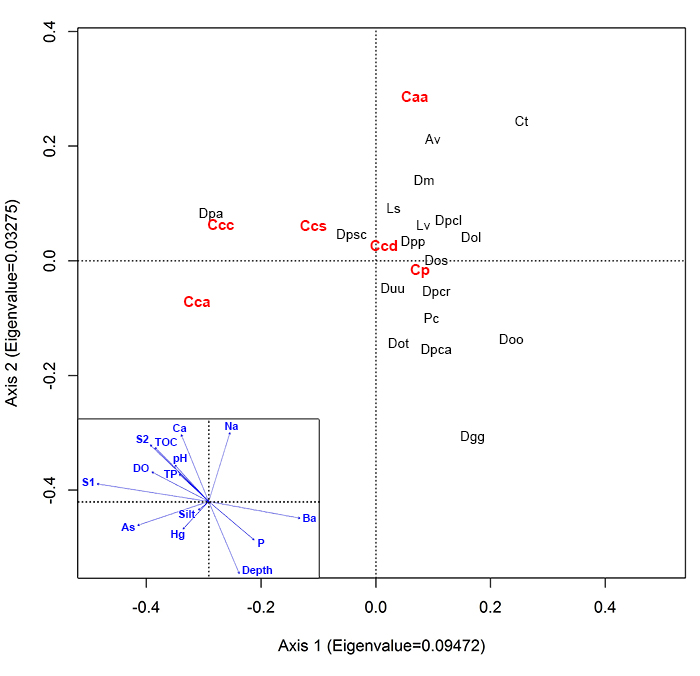
TABLE 1. Coordinates, quantitative arcellininid information and Shannon Diversity Index (SDI) values of the samples containing specimens of Centropyxis pontigulasiformis.
| C. pontigulasiformis | |||||||
| Sample ID | Transect | Lat. | Long. | Total Arcellininid Counts |
Absolute Abundance |
Relative Abundance (%) |
SDI |
| BC 5 | North | 62.6158 | -114.4944 | 338 | 4 | 1.1834 | 1.96 |
| BC 6 | North | 62.6362 | -114.4744 | 184 | 2 | 1.087 | 2.36 |
| BC 7 | North | 62.6147 | -114.4248 | 226 | 2 | 0.885 | 2.07 |
| BC 8 | North | 62.608 | -114.4045 | 317 | 13 | 4.1009 | 2.57 |
| BC 9 | North | 62.6063 | -114.4103 | 290 | 5 | 1.7241 | 2.6 |
| BC 11 | North | 62.584 | -114.3756 | 303 | 1 | 0.33 | 2.1 |
| BC 12 | North | 62.5987 | -114.4096 | 232 | 6 | 2.5862 | 2.23 |
| BC 13 | North | 62.5269 | -114.443 | 265 | 1 | 0.3774 | 2.16 |
| BC 17 | North | 62.5007 | -114.4201 | 291 | 2 | 0.6873 | 1.53 |
| BC 18 | North | 62.5184 | -114.3956 | 213 | 4 | 1.8779 | 1.84 |
| BC 19 | North | 62.5152 | -114.3974 | 222 | 9 | 4.0541 | 1.7 |
| BC 21 | North | 62.4882 | -114.4405 | 250 | 3 | 1.2 | 2.62 |
| BC 22 | West | 62.5411 | -114.84 | 143 | 41 | 28.6713 | 1.93 |
| BC 24 | West | 62.5466 | -114.7452 | 176 | 2 | 1.1364 | 1.64 |
| BC 30 | West | 62.5199 | -114.6072 | 264 | 1 | 0.3788 | 2.45 |
| BC 31 | West | 62.5418 | -114.578 | 278 | 5 | 1.7986 | 2.37 |
| BC 37 | East | 62.5189 | -113.9626 | 306 | 54 | 17.6471 | 1.89 |
| BC 39 | East | 62.4992 | -114.0331 | 284 | 2 | 0.7042 | 2.12 |
| BC 45 | East | 62.4962 | -114.2803 | 184 | 1 | 0.5435 | 2.25 |
| BC 46 | East | 62.527 | -114.3357 | 296 | 62 | 20.9459 | 1.93 |
| BC 52 | South | 62.2941 | -114.0033 | 266 | 2 | 0.7519 | 2.27 |
| BC 53 | South | 62.3087 | -114.0213 | 239 | 2 | 0.8368 | 2.31 |
| BC 57 | South | 62.3729 | -114.0998 | 264 | 1 | 0.3788 | 1.97 |
| BC 59 | South | 62.4161 | -114.1392 | 287 | 44 | 15.331 | 1.94 |
| BC 61 | South | 62.4876 | -114.2426 | 307 | 31 | 10.0977 | 2.11 |
Conicocassis, a new genus of Arcellinina (testate lobose amoebae)
Plain Language Abstract
Arcellinina (also informally known as testate lobose amoebae or thecamoebians) are a group of shelled microorganisms that are well-preserved in most Quaternary lake sediments, and are found from the equator to poles in a variety of fresh to brackish aquatic and terrestrial environments. More than 130 arcellininid species have been placed in the genus Centropyxis Stein, 1857, which is characterized by species with flattened, beret-like shells. Centropyxis pontigulasiformis Beyens et al., 1986 is distinct from the type species of genus Centropyxis, Centropyxis aculeata (Ehrenberg, 1832), in having a shell that is comprised of two distinctive components; an ovoid to subspherical main shell body with a pronounced funnel-like visor that extends from a small circular opening (aperture). Aside from its single-chambered shell that forms by binding various foreign materials, like sand particles and diatom shells, the species bears no similarity to C. aculeata. The new genus Conicocassis with type species Co. pontigulasiformis is proposed to include species with shells characterized by spherical to subspherical main test bodies and asymmetrically positioned funnel-like visor extending from around a small circular aperture.
Resumen en Español
Conicocassis, un nuevo género de Arcellinina (amebas lobosas testadas)
La superfamilia Arcellinina (informalmente conocida como tecamebas o amebas lobosas testadas) es un grupo de protistas bentónicos con testa comunes en la mayoría de los sedimentos lacustres cuaternarios. Se encuentran en todo el mundo, desde el ecuador a los polos, y viven en una gran variedad de hábitats terrestres y acuáticos de agua dulce a salobre. Más de 130 especies y cepas de Arcellinina se han atribuido al género Centropyxis Stein, 1857 dentro de la familia Centropyxidae Jung, 1942, que incluye las especies que se caracterizan por tener una testa (concha) orientada dorsoventralmente y que recuerda a una boina aplastada. Conicocassis es un nuevo género de la familia Centropyxidae (Arcellinina) que se diferencia de otros géneros de la familia, específicamente del género Centropyxis y su especie tipo C. aculeata (Ehrenberg, 1932), por tener una testa única formada por dos componentes distintos; un cuerpo de testa generalmente orientado dorsoventralmente y ovoide a subesférico, con un borde tipo embudo posicionado de forma notablemente asimétrica y que se extiende desde una pequeña abertura circular. La especie tipo del nuevo género, Conicocassis pontigulasiformis (Beyens et al., 1986) ha sido previamente encontrada en las turberas de Alemania, los Países Bajos y Austria, así como en musgos muy húmedos y ambientes acuáticos de las regiones del Alto Ártico de Europa y América del Norte . La presencia de la especie en ambientes lacustres en los Territorios del Noroeste centrales amplía la distribución geográfica conocida del género considerablemente hacia el sur en América del Norte.
Palabras clave: Arcellinina; Canadá; Conicocassis gen. nov.; Territorios del Noroeste; Cuaternario; amebas lobosas testadas
Traducción: Enrique Peñalver
Résumé en Français
Conicocassis, un nouveau genre d'Arcellinina (amibes lobées à thèque)
La superfamille des Arcellinina (aussi connue sous le nom de thécamibiens ou amibes lobées à thèque) est un groupe de protistes benthiques à coquilles communs dans la plupart des sédiments lacustres quaternaires. Ils sont trouvés dans le monde entier, de l'équateur aux pôles, habitant une variété d'habitats terrestres et aquatiques d'eau douce à saumâtre. Plus de 130 espèces et souches de thécamibiens sont attribuées au genre Centropyxis Stein, 1857 au sein de la famille Centropyxidae Jung, 1942, qui inclut des espèces caractérisées par une thèque (coquille) orientée dorso-ventralement et aplatie en forme de béret. Conicocassis, un nouveau genre de thécamibien Centropyxidae, diffère des autres genres de la famille, et en particulier du genre Centropyxis et de son espèce-type C. aculeata (Ehrenberg, 1932), par une thèque unique comprenant deux composantes distinctes : un corps de thèque généralement ovoïde à subsphérique et orienté dorso-ventralement, avec un prolongement en forme d'entonnoir, positionné de manière très asymétrique, et s'étendant à partir d'une petite ouverture circulaire. L'espèce-type du nouveau genre, Conicocassis pontigulasiformis (Beyens et al., 1986) a été signalée précédemment dans des tourbières en Allemagne, aux Pays-Bas, et en Autriche, ainsi que dans des des mousses très humides et des environnements aquatiques des régions du Haut-Arctique d'Europe et d'Amérique du Nord. La présence de cette espèce dans des environnements lacustres de la partie centrale des Territoires du Nord-Ouest étend considérablement vers le sud la distribution géographique connue de ce genre en Amérique du Nord.
Mots-clés : Arcellinina ; Canada ; Conicocassis gen. nov. ; Territoires du Nord-Ouest ; Quaternaire ; amibes lobées à thèque
Translator: Antoine Souron
Deutsche Zusammenfassung
In progress
Translator: Eva Gebauer
Arabic
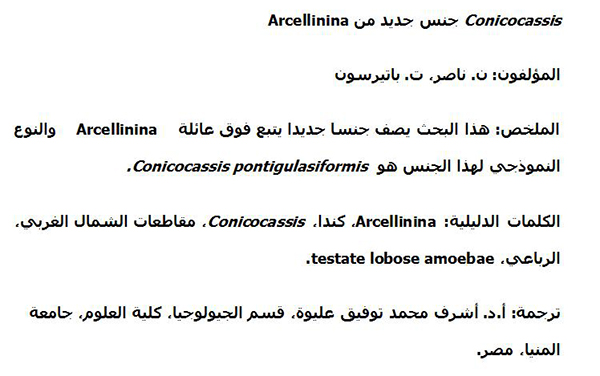
Translator: Ashraf M.T. Elewa
-
-
PE: An influential journal
 Palaeontologia Electronica among the most influential palaeontological journals
Palaeontologia Electronica among the most influential palaeontological journalsArticle number: 27.2.2E
July 2024





 A Review of Handbook of Paleoichthyology Volume 8a: Actinopterygii I, Palaeoniscimorpha, Stem Neopterygii, Chondrostei
A Review of Handbook of Paleoichthyology Volume 8a: Actinopterygii I, Palaeoniscimorpha, Stem Neopterygii, Chondrostei